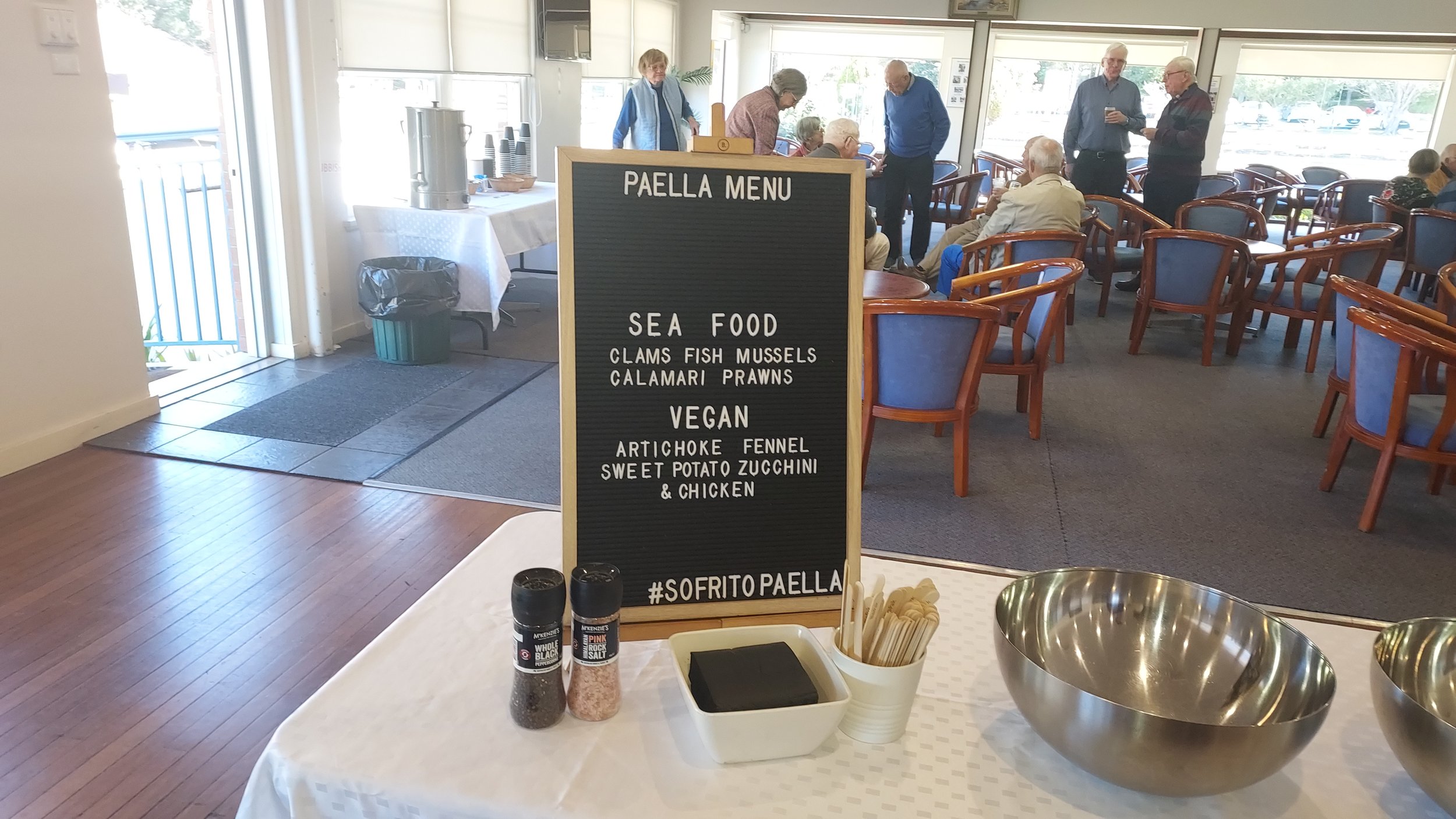July 2023 Newsletter
Chairmans Corner
Roger Parks
Spanish Lunch
I have received mixed feedback regarding this event with some diners dissatisfied.
The idea of the Spanish Lunch was brought to the Board by residents of Watermark, Castle Cove who had a very good experience with the caterer. Unfortunately, the experience was not replicated for our event and those last to be served were particularly displeased.
I spoke with the caterer in the days following mentioning our disappointment.
Keep Bowling
The Club reports on a financial year basis and I am very pleased to announce that we have now gone 2 years without flying the flag at half-mast. This is a wonderful achievement given the average age of our bowling members is almost 80.
Bowls provides key elements for healthy living: sunshine, moderate exercise and companionship.
The unmistakable message here is to keep bowling.
Behind the Scenes
To keep our club running smoothly, there are many activities going on behind the scenes which members may not be aware of.
Fire Services
Each year we are required by Council to prepare a Fire Safety Statement which assures all fire safety equipment is working. A specialist contractor is engaged to test the equipment and repair any defects. This sounds straight forward, but in the last 5 years we have terminated two contractors for poor performance and managed the introduction of new firms. This is both time consuming and costly as the new firm picks up deficiencies the previous firm overlooked. Our Treasurer, Ian Kimmorley has managed this in addition to all his other responsibilities.
Purchasing
With over 100 bowlers coming though the door each week, the Club consumes considerable amounts of food and beverage. Liz and Brian make sure the larder and fridges are kept stocked.
Rob Stutchbury checks out the wine specials at Dan Murphy’s and First Choice. The winning rink, raffle prizes and the bar have Rob purchasing and transporting more than 2 dozen bottles of wine every week.
Killara Bowling Club
I am often asked what is happening with the Killara Bowling Club. The latest I have been told is that their board is negotiating an amalgamation with the Norths Collective (North Sydney Leagues Club) and hope to take a proposal to their members sometime in August.
Happy Bowling
Roger Parks
Chairman
From the Women’s President
Lorraine Forster
Susie Meares has been successful in winning the club Consistency Singles. Susie defeated Neil Gosbell in a tight game. Congratulations Susie.
Louise Amos represented our club in the Champion of Champion singles - Zone 9 playoffs and won her way through to the third round while Julie Dunn and Lorraine Forster (sub for Anne Rands), competed in the CofC pairs, winning one match and losing the second. Congratulation to these ladies.
Our club competed in the St Ives 5 Carnival with our team winning three of our four games.
The Inter-District Jean McKinnon Shield was played at Mosman Bowling Club recently with Susie Meares, Julie Dunn, Ngoc Hau and Louise Amos being selected to play as a team representing the North Shore side. Our ladies won 289:261 against Manly-Warringah. The trophy (see below) was presented to the skips of the winning District.
The Jean McKinnon Shield winners, with their trophy, at Mosman Bowling Club
Lorraine Forster
Women’s President
A Word from the Editor
July is the seventh month in our calendar but in the ancient Roman calendar it was the fifth month. As such, it was known by the Romans as ‘Quintilis’, meaning ‘fifth’, until Julius Caesar decided that naming this month after himself was a better idea. And so it was that the month became known as Julius (later corrupted to July), a name we have stuck with ever since.
For the Romans, of course, it was the height of summer but for us it is the depth of winter, with cold mornings, short days and long shadows over Green 1. Not that these conditions have deterred our members, with good bowling numbers maintained throughout the period.
Your club continues to run smoothly and efficiently, with a sound financial basis, and thanks for that should go to the club leadership. As the Chairman has reminded us in his discourse elsewhere in this newsletter, there is so much that goes on behind the scenes at our club. For the most part the work is done by a mere handful of people, enabling us to keep the doors open and the welcome mat out.
In our last edition, many of you enjoyed reading a reprint of a newsletter from the very early days of our club. This time around we have another extract from the archives, which comes to us from the Ku-Ring-Gai Historical Society, courtesy of Judith Godden, assisted by Roger Parks.
The Bare Essentials
We know that many lawn bowls clubs now offer barefoot bowling, but which North Shore one was associated with a nudist camp? The answer is the Lindfield Bowling Club (now the Lindfield Rollers Bowling Club) in Carlyle Road, East Lindfield.
The origins of the Lindfield Bowling Club go back to 1948 when a group of local men formed a committee to establish a bowling club in east Lindfield. The Club was incorporated in 1950 and an ambitiously constructed clubhouse opened two years later. It soon had a waiting list of men eager to join. As was usual for the time, a Ladies Auxiliary was formed to help the men. Eventually, that wasn’t enough; the women acquired their own greens so they too could enjoy bowls.
All the greens were carved out of land which had been long neglected. In the remaining scrub leading down to Middle Harbour, tiger snakes and lyrebirds found refuge. The lyrebirds’ beautiful plumage and amazing ability to mimic resulted in the lyrebird becoming the Club’s official emblem. A flock of kookaburras was also a feature of the early Club, fed daily by the honorary gardener Jack Carr.
And what of the nudists? From the 1930s, ‘naturists’ had set up bush camps to enjoy what they saw as a healthier lifestyle without clothes. The idea was to experience the innocence enjoyed in the Garden of Eden. Outsiders scoffed at the philosophy and focused on the nudity, so that the naturists soon became known as nudists. In Sydney, being nude was only legal when on private property and out of public sight. In the 1950s, conservatives viewed nudism with extra suspicion because it was associated with the post-war influx of European migrants; it had been particularly popular in Germany in the inter-war period.
Ron Ashworth, an engineer who lived at Balgowlah, was the main promoter of Sydney’s nudist camps. He began a number of publications to promote being nude, most notably The Australian Sunbather; A Journal for Naturists. He also founded the Sun and Country Club which bought sites in Sydney’s bush for nudist camps. One camp was at Frenchs Forest, reportedly near the current Sydney Japanese International School. By 1951 Ron Ashworth claimed his Sun and Country Club had 430 members – a healthy number for a club but a tiny minority of Sydney’s population (then around 1.7 million).
The bowlers and nudists clubs both carefully restricted membership to the ‘respectable’ middle class. Ron Ashworth protected his members’ privacy by forbidding cameras and the use of surnames, but also their morals by forbidding dancing and alcohol. While there were shared values, the differences were massive – certainly no-one appears to have ever suggested that men should be flogged for playing bowls! And only in the nudists clubs was an all-over tan seen as a benefit of membership. While newspaper articles about nudists mention sun-lotion, most people in the 1950s were blissfully unaware of the dangers of skin cancer. They saw a tanned body as healthy and sunburn the price to pay for the joy of sunbaking.
How did the Lindfield Bowling Club become associated with a nudist camp? According to early member Norm Tyler, the camp was opposite to the Club. The nudists were some distance away, on a rocky area on the other side of Middle Harbour, but still visible if you cared to look. And many men did care to look. The word spread, with Norm Tyler commenting that the first thing visitors to the Club asked about was not bowls, but the nudists. Whether the nudists themselves knew or cared is not recorded.
Today the Lindfield Rollers is a thriving club for men and women bowlers. It offers a range of activities, but a view of naked bodies is not one of its attractions!
Judith Godden
This article was first published in the Sydney Observer in a series written by members of the Ku-ring-gai Historical Society, www.khs.org.au.
The club in the 1950’s (photo Courtesy Ku-Ring-Gai Historical Society)
Dinner at the club (photo Courtesy Lindfield Rollers) – not a bare bum in sight! But to this day you can hear the lyrebirds singing down in the Middle Harbour bush.
Garry Lowder
newsletter@lindfieldrollers.com.au
What’s been happening?
It may seem like ancient history now but, for the record, when the Open Gender Pennants competitions ended in early May this year our Grade 5 side had done well, missing out by just one point on making the play-offs. The Grade 6 team did not do so well, coming fifth in their section. Ah well, there’s always next year!
The club’s Major Singles and Major Pairs competitions are currently underway. With the Singles nearing completion. Meanwhile, Jeff Ware has proven himself to be one to watch after winning both the Rookies’ Singles (defeating Roger Crouch in the final) and the Minor Singles (defeating Bob Roger in the final).
Some 72 members and guests enjoyed a Spanish lunch at the club on Sunday, July 2nd. Featuring the traditional dish known as Paella, preceded by some tasty canapés, the occasion took place on a beautiful sunny day and, yes, a good time was had by all, even though the food started to run out a tad too early.
Our thanks go to Liz and her “work-husband” Brian for their efforts in making the day so successful.
Here are some photos from the day:
When Bias is Good
My thanks go to Warren King for providing the following article that explains that most mysterious of bowls attributes – the bias.
THE BIAS OF A LAWN BOWL
Warren King
The lawn bowl is not round, it is not a perfect sphere. This is deliberately done by the manufacturer. Looking at a bowl you will see the running side is round but the outside of the bowl is not. It has been flattened from the sphere shape and, importantly one side of the bowl is flatter than the other.
This difference in the two sides is produced at the time of manufacture. To produce a bowl a heated mass of plastic granules is inserted into a mould – with pressure. This mould determines the shape of the bowl. What comes out of the mould is a bowl with flattened sides and one side flatter than the other.
The result of one side being flatter than the other is that one side is heavier than the other. That is, the centre of gravity is displaced towards one side. The heavier side is marked on the bowl by the sign of a small disc. This difference in the weights of the two sides is the reason for the curve in the path of the bowl. As the bowl slows in its trajectory, the heavier side will take effect and cause the bowl to curve in that direction.
The draw of the bowl is the distance of the bowl’s final resting point from where it would have reached in a straight line. Many factors will affect the extent of the draw [weather, green surface, etc] but a critical factor is the bias of the bowl.
The degree of bias will vary depending on the shape of the mould used and the resulting displacement of the centre of gravity. Manufacturers will vary the mould according to the brand of the bowl. So that different brands will produce different degrees of bias and the resulting draw.
In conclusion a purpose of this article is to disprove that the bias is given by some form of weighting or loading inserted in one side, but solely by the shape of the bowl.
Have a look at your bowl next time to pick the different weighting of the sides.
Looking Ahead
A series of clinics designed for bowlers with less than three years bowling experience has been announced, due to take place in August. The aim is to give newer bowlers the skills that will enable them to continue to grow in their bowling careers.
The clinics will be held on three consecutive Saturdays beginning at 10.30 and last approximately 1.5 hours. Each clinic will have a different focus and less experienced bowlers are encouraged to attend all three.
Clinic 1: 5 August:
- The role of the 2nd in a game of triples and fours
- Playing around and under the dreaded short bowl
- Drills practicing what you have learnt
Clinic 2: 12 August:
- Reading the head and giving advice to the skip
- Playing with weight to move a jack or bowl
- Drills practicing what you have learnt
Clinic 3: 19 August:
- Measuring accurately
- Demonstration of the equipment in the umpires kit so that you understand how they are used
- Play some ends practicing everything you have learnt over the past 3 weeks.
Sign-up sheets will be placed on the noticeboard. It is important that we know the number of intending participants so that the correct number of coaches can be made available.
A Smile on Your Dial
Economic theory:
A short lesson on electric cars:
Beware! Retail sharks!
How is this even possible?
And then ….
Finally …
"The two most important days in your life are the day you are born and the day you find out why." – Mark Twain
Till next time …
















